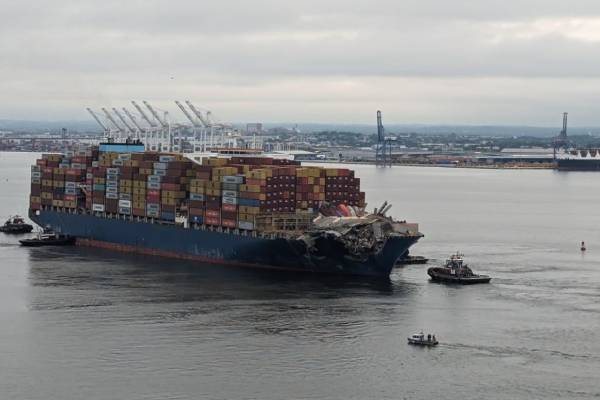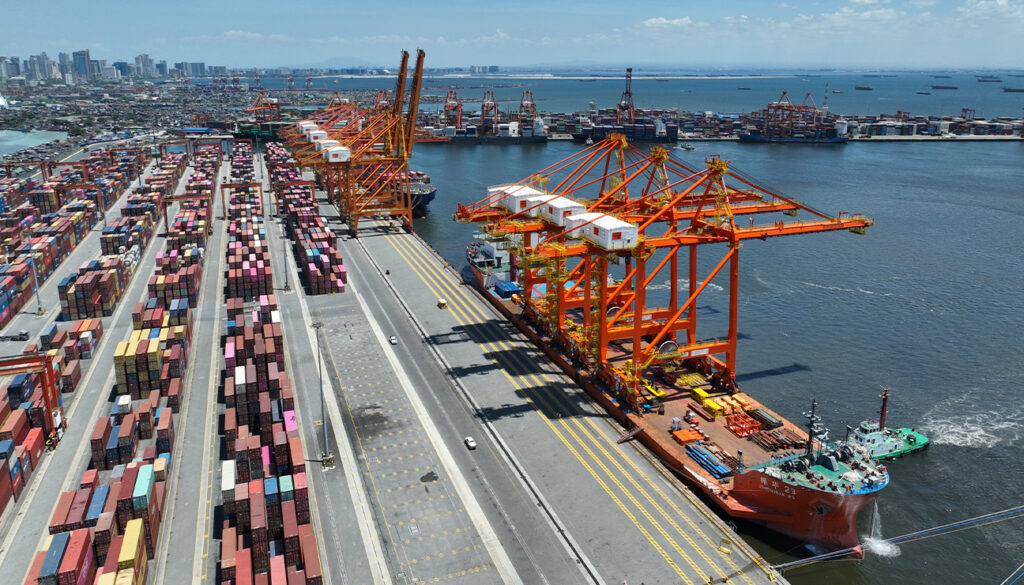Less than three months after the main spans of the Francis Scott Key Bridge became a mangled wreck in the Patapsco River, they are now almost entirely gone. And so the 700-foot wide full shipping channel is scheduled to reopen June 10 outside Baltimore.
Salvage crews removed the final large piece of steel truss blocking the Port of Baltimore’s main shipping channel earlier. They pulled one of the last remnants of the fallen bridge out of the water, opening the channel’s full reopening, according to the Unified Command.
“The continued work involves digging out the bottom cord of the remaining truss and cutting it into three sections to safely lift the wreckage,” spokesperson Kurt Rauschenberg said.
Twice the huge container ship Dali lost power and slammed into one of the bridge’s support columns early in the morning of March 26. The collision caused the Key Bridge to fall into the waters outside Baltimore, killing six and causing the closing to maritime traffic of one of the busiest ports on the East Coast.
The accident cost the Port of Baltimore, the nation’s 11th-largest, as much as $191 million a day in lost business when it was forced to close to maritime traffic. The Baltimore port leads North America in number of imported vehicles and light trucks.
Truckers working the East Coast lost a speedier alternative than running through the streets of Baltimore. Because hazmat vehicles are banned by Baltimore’s two tunnels running under the Chesapeake Bay, it usually means an hour or more rerouting.
The Key Bridge carried an average of about 30,000 vehicles every day. It was a critical connector for freight trucks carrying hazardous materials through the state or to and from the port.
It will take just over four years and up to $1.9 billion to rebuild the Key Bridge after it was hit by the cargo ship and fell into the Patapsco River, according to an estimate by the Maryland Department of Transportation.
President Joe Biden has said the federal government will pay for “every cent” of the $1.9 billion. But typical of Washington, there is teeth-gnashing over the cost by Republicans in Congress.
Twice on the day before the calamity, the Dali lost power in its electrical system, a 24-page preliminary report by the National Transportation Safety Board (NTSB) shows.
Since a deep-water channel opened to the Port of Baltimore on May 14, some roll-on/roll-off (RoRo) and container vessel traffic has resumed. Supply chain visibility platform project44 has released a new data report on the current state of port operations in the wake of the Francis Scott Key Bridge collapse. Highlights include:
- Vessel berthing (processing) time at the Port of Baltimore decreased from a peak of over 10 days after the bridge collapse to just 0.19 days at the end of May;
- Export dwell time is likely to remain high for the next few weeks as the backlog of exports are loaded onto vessels;
- The Port of Baltimore has seen RoRo and container vessel traffic resume with the opening of a deep-water channel;
- Rough estimates point to a potential cost of over $37 million in demurrage since the accident in March; and
- Shipments originally destined for Baltimore were rerouted primarily to New York (55%), Norfolk (22%), and Newark-Elizabeth (9%)
Rough estimates point to a potential cost of more than $37 million in demurrage since the bridge collapse in March. Salvage and demolition crews are focused primarily on freeing the Dali from about 50,000 tons of steel that came crashing down on the ship’s bow, according to estimates from research firm Project44.
The Dali was refloated in mid-May and guided back into the Port of Baltimore. That allowed most maritime traffic to resume through the busy East Coast port.
Meanwhile, the broker for the bridge’s insurance policy confirmed a $350 million payout will be made to the state of Maryland in what is expected to be the first of many payouts related to the collapse. The NTSB investigation is continuing.
The NTSB is one are four separate investigations into the accident that caused the bridge to fall and create what is likely to be the most expensive litigation in maritime history:
- The NTSB office of Marine Safety and Office of Highway Safety are examining what went wrong aboard the Dali and the structural components of the bridge;
- The Coast Guard’s Marine Board of Investigation is looking into the ship crash “in accordance with all applicable statutory and regulator mandates,” it says. FBI agents have already boarded the ship, still located in the Patapsco River, using a search warrant to seize cell phones from the 22 or so maritime workers, mostly from the Far East. It is not known to what extent the FBI is investigating and
- Maryland Occupational Safety and Health. Six highway construction workers died.
The Maryland Transportation Authority is accepting bids for the new bridge this month and hopes to select a contractor before the end of the summer.




